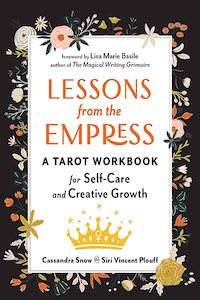
Lessons from the Empress: A Tarot Workbook for Self-Care and Creative Growth, by Cassandra Snow and Siri Vincent Plouff
Weiser Books, 1578637937, 224 pages, October 2022
I’d been contemplating how I wanted to honor Venus retrograde from July 22nd to September 3rd of this year. Since the retrograde is happening in my first house of self, I settled on examining my relationships to self-care and creative pursuits, which admittedly have been low on my list of priorities after the past six months of postpartum life tending to a new baby. This retrograde feels like a sacred time to nourish myself and my creative pursuits, and luckily, I found the perfect book to guide me through: Lessons from the Empress: A Tarot Workbook for Self-Care and Creative Growth by Cassandra Snow and Siri Vincent Plouff.
“… we can recognize that creativity is not just for the chosen few but that it is our own birthright to create. In fact, creativity as the ultimate form of self-care is self-expression exalted.”1
This book opens news doors for self-care and magical practice with the tarot. The authors describe how the Empress teaches how to nurture ourselves through physical senses into our lives, working “in partnership with the materia” and through “taste, sight, smell, hearing, and touch”2. The prompts, tarot spreads, and rituals help to create the grounded life structure for our abundance, creativity, and self-care to flourish.
Divided into three parts, readers are led through preparation, journeying inward, and arriving at self-acceptance through the tarot. The slow and steady build anchors the reader in their own body as they open to receive the wisdom of the Empress. There’s no need to rush through. And being a workbook, Lessons from the Empress requires time and space for the reader to truly dive in and do the tarot readings, writing prompts, and integrate their reflections.
The journey begins with discovering one’s own inner empress. The authors offers creative ideas for self-care, a tarot spread to learn more about your current self-care practice, and a dedication opening ritual. Then she provides the tarot basics for readers who don’t know much about the tarot: picking out a deck, the general meaning of the suits, and how tarot reading is really a form of story-telling. Once the foundation is laid for generally understanding tarot, the focus switches to using tarot cards to create rituals, specifically self-care rituals.
“Some people struggle to create healthy routines for their self-care, but you are worth the time and effort it takes to establish them.”3
After some initiatory tarot spreads, the journey deepens as the reader enters the major arcana. The authors tells the full story of the major arcana from The Fool to The World to help readers understand the archetypal and spiritual journey of tarot, framing it in different ways for readers to see connections between the cards. Then there are major arcana spreads, self-care prompts, and creative prompts for the reader to do, along with a ritual to spark fresh ideas.
Finally, the third part of the book focuses on the minor arcana, and it is by far the longest section! Just as the readers were guided through the story of the major arcana, the authors now turn to telling the story of each suit (wands, cups, swords, and pentacles) from beginning to end with the court cards described separately. Following the same format, there’s a spread for each suit, self-care prompts, creative prompts, and a culminating ritual.
Throughout the book are tools for the readers to further their tarot knowledge and magical practice. For instance, there’s “get to know the cards“ charts for the major arcana, minor arcana cards by suit, and court cards by suit that have traditional associations for the cards along with a blank column for readers to fill in their own personal associations.
The authors also offers styles of witchcraft and styles of creativity for the different types of cards. For instance, the styles of witchcraft suggested for the wands include candle magic, sex magic, trusting the gut instinct. While styles of creativity for swords include automatic writing, journaling, reading, and blending scents.
As with any workbook, you get what you put in! While the content of the book is very interesting to read, especially the stories of the major arcana and each suit, truly undergoing the journey of the Empress involves creating the space and routine to do the spreads, practice intentional creativity, and tap into your own magic.
For me, the structure of the book has been good for keeping me organized and on task! When I feel my self-care routine slipping or am feeling low (a sign I’m out of touch with my creativity), I can go back and pick up where I left off, and usually I get right back into my flow. This being said, it has been weeks that I’ve been moving through the book, and I’m only through the major arcana and one suit. But that’s okay! If I’ve learned anything from the Empress so far it’s that I can indulge in my creativity, take my time, and let things happen at their own pace.
Overall, Lessons from the Empress is a fun way to cultivate a self-care practice. It’s unique in the way it invites the elemental magic of the tarot to inspire the readers and focuses on creativity as a source of self-care. Whether you’re new to tarot reading or have years of experience, embracing the tarot with the focus of self-care is a new experience, opening up yet another way the tarot can be used as a spiritual tool for personal growth.
Alanna Kali is an astrologer, numerologist, and pioneer spirit that loves to explore life through the lens of depth psychology. She has a passion for studying the humanities and social trends. Her academic work is centered upon reuniting body, mind, and spirit through eco-psychology. She loves reading, spending time in nature, and travel.
